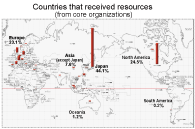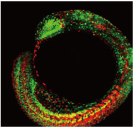|
 |
■Bioresources information is available at the following URLs
|
 |
|
Introduction to Resource Center <No. 45>  NBRP - Zebrafish NBRP - Zebrafish
Hitoshi Okamoto (Developmental Gene Regulation, RIKEN Brain Science Institute)
Koichi Kawakami (National Institute of Genetics)
Shin-ichi Higashijima (National Institutes of Natural Sciences)
Japan has achieved a high level of zebrafish research, and Japan is a world leader with regard to technologies to produce transgenic zebrafish strains and research using these strains. Unique and high-quality resources have been continuously produced in Japan. However, the risk of losing resources always existed in the past due to unstable positions of young researchers and small-scale rearing facilities. Therefore, the significance of the National BioResearch Project (NBRP)-Zebrafish in its early stage was to prevent Japan’s precious resources from being lost and to distribute these resources to foreign and domestic researchers, which resulted in a significant contribution to global scientific development. In the zebrafish community of Japan, the number of researchers with stable positions has increased. Compared to the early stage of the NBRP-Zebrafish, the community has matured to a certain extent recently. At present, the proportion of zebrafish resources distributed overseas is notably high (more than half of the strains are distributed overseas) (Fig. 1).
The fact that more than half of the strains have been distributed overseas indicates that the resources produced in Japan and kept in the NBRP-Zebrafish are highly valued internationally. Papers on zebrafish strains distributed to researchers through the NBRP have been published in world-renowned journals such as Science, Nature, Developmental Cell, Neuron, Nature Neuroscience, and Development (Fig. 2). |

Fig. 1: Countries that received resources from core organizations between 2007−2011 (a total of 549 cases) |
|

Fig/ 2: Fucci fish (provided by Dr. Atsushi Miyawaki) |
|
The embryonic development of zebrafish can be investigated by using the Fucci method that was developed by Dr. Atsushi Miyawaki. In this method, nuclei of cells in the G1 stage exhibit orange fluorescence and nuclei in cells in the S/G2/M stage exhibit green fluorescence. The cell division can be observed by using the change in the fluorescent color. In the period between April 2009 and June 2012, 182 zebrafish strains were distributed to foreign and domestic researchers. |
|
RIKEN, the core-facility of the NBRP-Zebrafish, collects general information on zebrafish strains developed in Japan and urges researchers to deposit zebrafish strains in the project. Through these activities, RIKEN has been collecting, conserving, and distributing zebrafish strains. The National Institute of Genetics and the National Institutes of Natural Sciences, which are sub-facilities, collect unique transgenic strains∗1, which have been continuously produced using extra funds, and distribute even unpublished strains according to the request of foreign and domestic researchers (the Research Organization of Information and Systems keeps enhancer-trap strains∗2 and gene-trap strains∗3 and the National Institutes of Natural Sciences keep transgenic strains that are related to the nervous system). Because each facility collects and distributes different strains, a multi-facility system can conserve a large number of strains and distribute them effectively.
| |
∗1: |
Strains, into which exogenous DNA that is not originally possessed by the organism has been introduced. |
| |
∗2: |
Strains, in which a reporter gene∗ has been inserted near the enhancer region∗∗ in the genome.
When a reporter gene is inserted near the enhancer region of gene A, the reporter gene is also controlled by the enhancer. Therefore, the expression pattern of gene A can be estimated from the observation results of the reporter gene.
|
| |
∗ |
Reporter gene: A gene used to observe a certain phenomenon. Green fluorescent protein (GFP) is a typical reporter gene. The reporter gene to be inserted has a weak promoter at the upstream side. |
| |
∗∗ |
Enhancer: A DNA region that controls the transcription (expression) of a gene.
|
| |
∗3: |
Mutant strains, in which a reporter gene without possessing a promoter has been inserted into a gene in the genome. In this case, the reporter gene is fused with the gene at the insertion site and the transcription is regulated by the promoter.
|
Recently, zebrafish strains have been distributed to researchers not only in the fields of embryology and genetics but also in the fields of medicine and pharmacy. This is because research using mammals such as mice is difficult to conduct due to cost performance and animal welfare concerns; furthermore, medical and pharmaceutical researchers have recognized the usefulness of zebrafish as a human disease model. These developments are predicted to continue in the future. In order to reach the goal of collecting, conserving, and distributing all strains produced in Japan within a limited budget, we have made every effort to improve the management efficiency of the NBRP-Zebrafish, including the development of a reliable method for sperm cryopreservation based on technologies taught by a community studying Oryziatidae.
The Zebrafish International Resource Center (ZIRC) in the USA is the largest foreign resource center. The NBRP-Zebrafish essentially collects resources originating in Japan, and our resources are very unique. For our resources to become internationally well known, the NBRP-Zebrafish started collaboration with the ZIRC so that our resources can be searched not only from the NBRP-Zebrafish website but also from the ZIRC website. The NBRP-Zebrafish also collaborates with resource centers and research communities in Asian countries, including Taiwan.
In addition to collecting, conserving, and distributing zebrafish strains, which are the basic activities of the NBRP-Zebrafish, the NBRP-Zebrafish has been supporting communities studying zebrafish in various other forms. Upon request, RIKEN offers individual courses in the method of sperm cryopreservation and gives advice about rearing and transportation methods of zebrafish. The Research Organization of Information and Systems performs activities that are supported by Riken in the form of collaborative research funds. In these activities, foreign and domestic researchers stay in the facility for a short period of time, observe the examination of a strain, and receive the strain. The National Institutes of Natural Sciences offers a technical course in transgenic zebrafish.
The NBRP-Zebrafish management committee meets once a year. In addition, a meeting via e-mail is held if necessary. At present, Professor Masahiko Hibi of Nagoya University is the chairman of the committee, and the committee consists of 5 members from the core- and sub-facilities and 13 members from the user institutions. To the management committee that meets once a year, activities of the core- and sub-facilities are reported, and the committee members discuss and assess the business plan. When a change in the business plan or a new business plan is proposed to the management committee, at community meetings, or circulated using the mailing list, the management committee members actively ask the core- and sub-facilities to consider the proposal.
The Great East Japan Earthquake that occurred in March 2011 caused damage to some zebrafish strains that were kept in research institutes in the Tohoku region. The NBRP-Zebrafish provided the damaged institutes with packing materials, heat insulating materials, and oxygen cylinders used for fish transportation to support the emergency evacuation of zebrafish strains. The NBRP-Zebrafish distributed strains to the damaged institutes after the situation calmed down. The distributed strains were the backups of the strains that had been lost during the earthquake and that were kept in the NBRP-Zebrafish. The frozen sperm of collected strains have been mutually stored in the NBRP-Zebrafish and the NBRP-Medaka so that a system of conserving backups has been established. Zebrafish and medaka are typical small-sized fish species used for genetic experiments. We have been establishing a system, in which these 2 species are complementary to each other.
|
References
Sugiyama M, Sakaue-Sawano A, Iimura T, Fukami K, Kitaguchi T, Kawakami K, Okamoto H, Higashijima S, Miyawaki A Illuminating cell-cycle progression in the developing zebrafish embryo. Proc Natl Acad Sci U S A. 2009 106:20812-20817. |
|
|
Website and Location Information |

Many of you may have experienced an eerie feeling when online advertisements appear to guess your physical location when surfing the internet. Services are expected to be improved if they collect information on "who" did "what" and "where," but it is not pleasant when information related to "what" and "where" are collected without explicit permission, even if such information is anonymous. In this edition, I focus on the "where" aspect of information tracking and introduce browser settings that can disable the disclosure of location information.

① Disallowing websites from requesting geolocations
Modern browsers have settings that give the option of automatically refusing the disclosure of geolocations when they are requested by a website. However, this option is set to "off" by default on IE 9, IE 10, and Firefox, so you have to explicitly set it to "on" if you wish to disallow access to your geolocation. The steps for turning this option "on" are provided below for IE 9, IE 10, and Firefox. The instructions for Safari 5 are not covered in this article because in this browser, the option is turned "on" by default.
E9, IE10
To disallow requests for your physical location in IE 9 and IE 10, mark the checkbox next to “Never allow websites to request your physical location” in the “Location” section of the [Privacy] tab and click on [Apply] (Fig. 1).
Firefox
To disallow geolocation requests in Firefox, select the checkbox next to “Tell web sites I do not want to be tracked” in the “Tracking” section of the privacy settings and click on [OK] (Fig. 2).

② Identifying the physical locations of websites
You can identify the physical location of a website based on its domain name and IP address, although this is a cumbersome procedure if it is performed for every website. Thus, I introduce a Firefox plugin that can tell you the location of the website you are currently viewing.
Flagfox
This plugin displays the website location using a flag icon on the browser's navigation bar. If you move your mouse over the flag icon, it will display more detailed information related to the server. For example, the domain suffix of Google Japan's homepage indicates that it is "Japan" (Fig. 3B), but it is clear that the web server actually resides in the "USA" (Fig. 3A).
The following describes how to install this plugin.
| 
Fig. 1: IE 9 setting for disallowing websites from requesting your physical location

Fig. 2: Firefox option for disallowing geolocation disclosure, which can be accessed through
[Tool > Options > Privacy]

Fig. 3: Flagfox display for Google Japan |
| ① |
Start Firefox and open the Flagfox distribution page:
Flagfox: https://addons.mozilla.org/en-US/firefox/addon/flagfox/ |
| ② |
Click on the [+Add to Firefox] button, and then click on [Allow] in the popup dialog. |
| ③ |
A software installation dialog box is displayed. Click on the [Install Now] button and restart Firefox. |
| ④ |
As shown in Fig. 3A, a country flag is shown on the navigation bar. You may make some interesting discoveries when examining websites that you visit frequently. For example, the “SHIGEN” website resides in Japan in terms of both its domain name and server location. |
Browsers that we use without much thought are evolving constantly. Some of these changes may include the addition of functionalities related to privacy. Why not take this opportunity to review your browser’s privacy settings ?
(Tohru Watanabe) |
|
|
|
Wheat Genetic Resource Database " KOMUGI "
|

・Number of strains: 13,013
・Number of genes: 2,860
・Number of papers: 2,982
(as of April 2013) |
| DB name: |
Wheat Genetic Resource Database "KOMUGI" |
| URL: |
http://www.shigen.nig.ac.jp/wheat/komugi/ |
| Language: |
Japanese, English |
| Original contents: |
| |
・Wheat resources for research
(wild species, landraces, experimental lines, cDNA clones, etc.)
・Gene catalog, marker, EST, microarray information
・Literature information on wheat
・eWIS, story of wheat, organelles, chromosome information, etc. |
| Features: |
Information on various wheat resources (including rye and oat), e.g., wild species, cultivars, and experimental lines can be obtained, and resources can be ordered from the website.
Genetic information (MacGene) and eWIS (electronic newsletter for wheat) are regularly updated. |
| Cooperative DB:
TriFLDB |
| DB construction group: |
| |
NBRP-Wheat, members of creating the wheat gene catalog, NBRP Information |
| Management organization: Genetic ResourceCenter, NIG |
| Year of first DB publication: 1996 Year of last DB update: 2013 |
|
Comment from a practicing developer: KOMUGI is one of the oldest resource databases in Japan. Our database contains information on various types of strains and easy-to-understand commentaries for the general public, which show that the level of wheat scientists’ awareness is very high in Japan. We have constructed a catalog database of wheat genes together with international groups, updated the database every year, and published the catalog in PDF form, which is a dictionary format. With regard to cDNA clones, whose number has rapidly increased since 2002, because the arrangement of cDNA clones took time, we recently published the list of all cDNA clones and improved the user interface for BLAST. Two years ago, a database working group was formed in the NBRP-Wheat. At present, researchers together with developers plan a large-scale renewal of KOMUGI. Please check out the renewed database and do not hesitate to express your comments, questions, or opinions.
|
|
|
 NBRP - Zebrafish
NBRP - Zebrafish